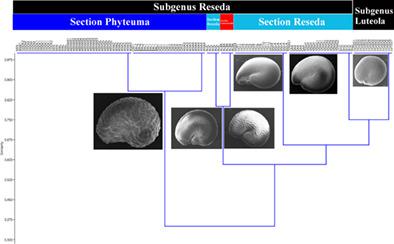当前位置:
X-MOL 学术
›
Microsc. Res. Tech.
›
论文详情
Our official English website, www.x-mol.net, welcomes your
feedback! (Note: you will need to create a separate account there.)
The impact of seed micromorphology in the subgeneric classification of the genus Reseda L. (Resedaceae) in Turkey
Microscopy Research and Technique ( IF 2.0 ) Pub Date : 2021-03-17 , DOI: 10.1002/jemt.23755 Emre Çilden 1 , Şinasi Yıldırımlı 1
Microscopy Research and Technique ( IF 2.0 ) Pub Date : 2021-03-17 , DOI: 10.1002/jemt.23755 Emre Çilden 1 , Şinasi Yıldırımlı 1
Affiliation

|
Seed micromorphology of 18 taxa belonging to the genus Reseda (Resedaceae) in Turkey were investigated with scanning electron microscopy (SEM), in order to understand and check its diagnostic significance at subgeneric and sectional level. Seeds of Reseda species were photographed to evaluate different characteristics including appearance of the seed, testa ornamentation and the existence of carunculoid tissue at hilum regions. In addition, cluster analysis and principal component analysis (PCA) were performed to test whether the micromorphological data of the related taxa is compatible with the current classification of the genus. According to seed micromorphology, Reseda taxa in Turkey are divided into four main groups particularly by testa ornamentation as papillose, rugose, rugulose, and smooth. These results are also in agreement with the sectional classification of the genus in morphological and molecular perspective. The tree topology of Unweighted Pair Group Method with Arithmetic Average based on seed features supported the traditional classification. Principle component analysis revealed testa surface ornamentation as the most distinctive character for species identification. PCA also confirms our cluster grouping of the subgeneric and sectional classification of the taxa in Turkey. An identification key for the genus Reseda in Turkey is provided in the light of current data. The seed data is helpful for the identification of the genus Reseda in Turkey at sectional level. However, for an accurate identification at specific level, seed micromorphology is not sufficient alone and must be evaluated together with all diagnostic morphological features.
中文翻译:

种子微形态对土耳其 Reseda L. (Resedaceae) 属亚属分类的影响
用扫描电子显微镜 (SEM) 研究了土耳其Reseda (Resedaceae)属 18 个分类群的种子微形态学,以了解和检查其在亚属和截面水平上的诊断意义。对Reseda物种的种子进行拍照以评估不同的特征,包括种子的外观、种皮装饰和在种脐区域是否存在类瘤组织。此外,还进行了聚类分析和主成分分析(PCA)以测试相关类群的微形态数据是否与该属的当前分类兼容。根据种子微形态学,Reseda土耳其的分类群分为四个主要组,特别是通过种皮装饰为乳头状、皱纹、皱纹和光滑。这些结果在形态学和分子学上也与该属的截面分类一致。基于种子特征的算术平均未加权对组方法的树拓扑支持传统分类。主成分分析表明种皮表面纹饰是物种鉴定中最显着的特征。PCA 还证实了我们对土耳其分类群的亚属和部分分类的聚类分组。根据当前数据提供了土耳其Reseda属的识别密钥。种子数据有助于Reseda属的鉴定在土耳其的部分级别。然而,对于特定水平的准确识别,仅靠种子微形态学是不够的,必须与所有诊断形态学特征一起进行评估。
更新日期:2021-03-17
中文翻译:

种子微形态对土耳其 Reseda L. (Resedaceae) 属亚属分类的影响
用扫描电子显微镜 (SEM) 研究了土耳其Reseda (Resedaceae)属 18 个分类群的种子微形态学,以了解和检查其在亚属和截面水平上的诊断意义。对Reseda物种的种子进行拍照以评估不同的特征,包括种子的外观、种皮装饰和在种脐区域是否存在类瘤组织。此外,还进行了聚类分析和主成分分析(PCA)以测试相关类群的微形态数据是否与该属的当前分类兼容。根据种子微形态学,Reseda土耳其的分类群分为四个主要组,特别是通过种皮装饰为乳头状、皱纹、皱纹和光滑。这些结果在形态学和分子学上也与该属的截面分类一致。基于种子特征的算术平均未加权对组方法的树拓扑支持传统分类。主成分分析表明种皮表面纹饰是物种鉴定中最显着的特征。PCA 还证实了我们对土耳其分类群的亚属和部分分类的聚类分组。根据当前数据提供了土耳其Reseda属的识别密钥。种子数据有助于Reseda属的鉴定在土耳其的部分级别。然而,对于特定水平的准确识别,仅靠种子微形态学是不够的,必须与所有诊断形态学特征一起进行评估。











































 京公网安备 11010802027423号
京公网安备 11010802027423号